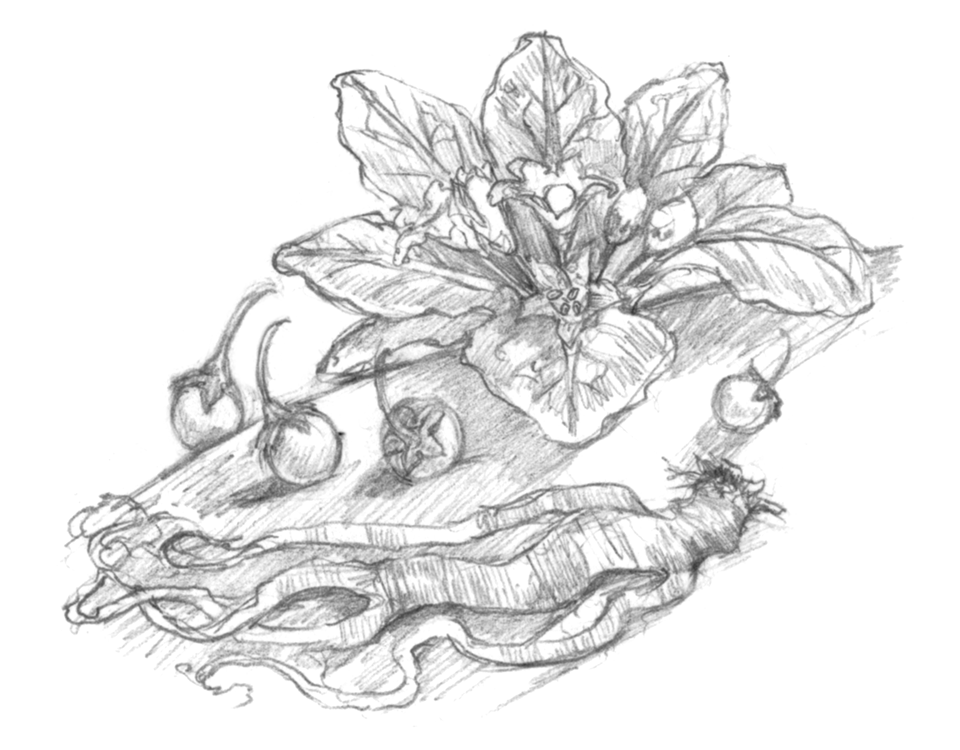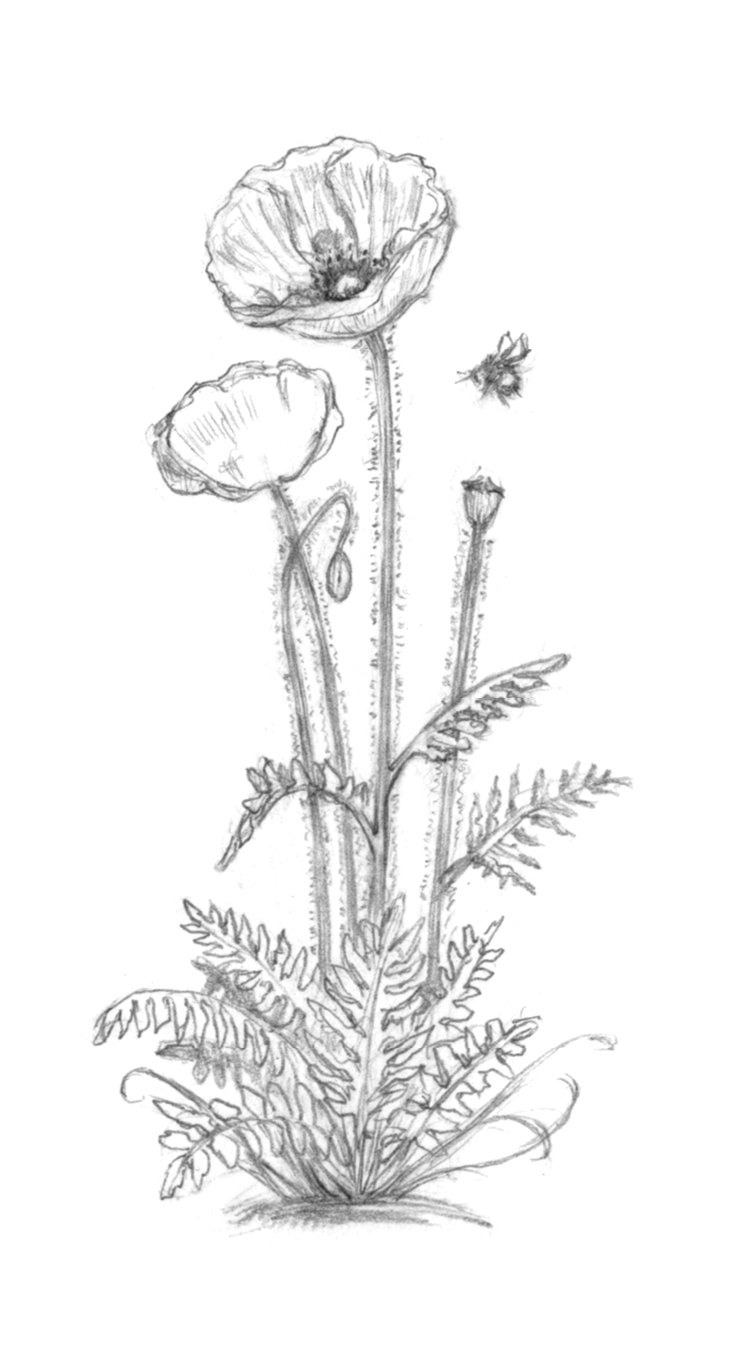Garden Witch's Herbal (23 page)
Read Garden Witch's Herbal Online
Authors: Ellen Dugan
Tags: #witchcraft, #wicca, #spells, #herb, #herbal, #herbalism, #garden, #gardening, #magical herbs, #herb gardening, #plants, #Pagan garden, #nature, #natural, #natural magick, #natural magic


mandrake
Mandrake (
Mandragora officinarum
)
Folk names include devil's apple, herb of Circe, ladykins, mannikin, and womandrake. This baneful herb is sacred to Aphrodite and is a native plant of Europe. It has long, oval-shaped leaves that are pointed at the tips. The leaves are described as “malodorous,” meaning they stink. The plant does bloomâa pale violet-colored flower in the spring that then matures to round, yellow, pineapple-scented fruits. These toxic fruits were called the golden apples of Aphrodite.
Mandragora
can grow up to twelve inches in height and has a long, parsnip-looking root that often resembles a human shape. According to plant folklore, the mandrake screams when it is pulled from the earthâand for best results, you were supposed to pull out the plant by circling it with silver and then in one swift pull remove the entire plant, with the root intact.
The root of the mandrake is what is typically used in magick. Mandrake root is one of the world's oldest narcotics. It is a hallucinogen, and this is one of the herbs often worked into “flying ointments.” This herb is classified as a masculine herb, and it has the reputation of being a Witch's hexing herb. For magickal operations, the mandrake is employed as an amulet. The root of the mandrake was often used as a poppet to represent a person. Just possessing a mandrake root and carrying it as a charm was thought to protect the bearer from possession and to bring good health. The root was sometimes displayed upon the mantle of the fireplace to bring success, wealth, and joy to the entire home.
In the language of flowers, mandrake signifies rarity. The astrological correspondence for
Mandragora
is Mercury, and the elemental association is fire.
Warning:
This plant is legally restricted in some countries. All parts of the mandrake are extremely toxic and should be handled with caution. Do not ingest.

rue
Rue (
Ruta graveolens
)
Folk names include herb of grace, mother of the herbs, Ruta, Witch bane, and garden rue. The rue is an evergreen shrub that can grow from two to three feet in height. It bears small, bright, buttonlike yellow flowers in the summer. The leaves are smooth, deeply divided, and have a greenish blue color. The scent of the rue is described as bracing, and the leaves of this plant are covered in oil glands.
I grow rue in my sunny perennial gardens. It makes a lovely specimen shrub. I clip it into a neatly shaped shrub every summer after it has finished blooming. I wear gardening gloves to do this because the oil from the leaves gives me a bit of a mild rash. Discarded rue foliage is also supposed to help your compost pile break down faster. I toss a few stems into my compost heap every year.
In magick, rue is often used for hex breaking and for warding off the evil eye. Rue is also a classic herb for protection magick and to increase your psychic powers; also, some old love spells call for rue. You can easily tuck a few rue leaves or flowers into a protective sachet. The scent of the plant is strong, so I would not recommend wearing the charm bag; instead, place it inside a purse, briefcase, or drawer. Just be sure to keep it out of the reach of children. Also, to be on the safe side, women who are pregnant should avoid contact with rue.
In the language of flowers, rue signifies grace, clear vision, virtue, atonement, and fresh starts. Rue is a popular herb with Italian traditional Witches, the Strega. Rue foliage is a common theme in magickal silver jewelry called the cimaruta as well. The plant is sacred to Diana and Aradia. This masculine herb is ruled by the sun, and its elemental correspondence is fire.
Warning:
Rue is a toxic plant. Brushing against the foliage may cause contact dermatitis. Do not take internally. It is also an abortifacient.

wild poppy
Wild Poppy (
Papaver rhoeas
)
Folk names include corn poppy, corn rose, field poppy, scarlet poppy, and red poppy. The red wild poppy is an annual that grows to about twelve inches in height. It has long, narrow leaves and a black, hairy stalk. The scarlet-colored flowers bear four petals and have a black center; it blooms in the late spring. The nectar from the field poppy intoxicates bees. These enchanting flowers make an excellent substitute in a Witch's garden for the opium poppy (
Papaver somniferum
), which is banned worldwide, as it is illegal to grow or to possess.
In the language of flowers, the wild poppy has many definitions. An orange poppy symbolizes vanity, while a red poppy stands for comfort. A white poppy whispers of a forgetful and restful sleep and that “I need time to consider your proposal.” The Oriental poppy demands silence, while a scarlet-colored wild poppy shouts of decadence.
The poppy is also a symbol of remembrance for those who have fallen in battle. The poppy is also associated with fertility. There are also rumors that the field poppy seeds were once worked into antidotes to unethical love potions.
Magickal uses include love, good luck, prosperity, and sleepâremember the scene from the
Wizard of Oz
movie when Dorothy and her companions fall asleep while running through a field of red poppies? Since the earliest of times, the red poppy has been a symbol of agricultural fecundity. The poppy is sacred to the agricultural goddesses Demeter and Ceres, and it was also grown in the garden of Hecate. It is also a symbol of the messenger god Hermes. Ruled by the moon, the poppyâno matter what its colorâis associated with the element of water.
Warning
:
The foliage of
Papaver rhoeas
is mildly toxic.

wormwood
Wormwood (
Artemisa absinthium
)
Folk names include absinthe, green ginger, and old woman. A perennial plant that is native to Eurasia and North Africa, it has silvery green foliage, grows to about three feet in height, and can be grown into a hedge. The leaves and the flower heads are a pale green color; as the flowers mature, they change to a golden brown. Wormwood blooms in midsummer.
Wormwood is the bitter herb used to flavor vermouth and the liqueur absinthe. The scent of wormwood is thought to increase psychic abilities. This herb is also dried and worked into sachets to repel moths and fleas. Legend states that if you burn the plant at a graveyard, it will summon the spirit of the departed. If wormwood is carried in a sachet or charm bag, it protects against bewitchment. This baneful herb was also worked into enchantments for love. It is sacred to Artemis, Pan, and Diana.
In the language of flowers, wormwood symbolizes a sad parting of friends. This is classified as a masculine plant. Its astrological influences are the planet Mars and the element of fire.
Warning:
This plant is considered to be toxic and should not be ingested.

yew
Yew (
Taxus baccata
)
The English yew was considered protective if grown in the garden, yard, or churchyard. Yew is a slow-growing and long-lived evergreen that can grow from fifty to eighty feet in height. The tree has a rounded crown and rusty brown, scaly bark. The “leaves” are deep green, flattened needles alternately arranged on the stems. This is a dioecious tree, meaning there are male and female plants. The male yew has flowers that are small, round cones. They release their pollen in the early spring. The female yew has a flower that is described as a small green bud, which is then followed by the red, fleshy fruit.
This tree was sacred to the Druids and is rumored to have been used in their ceremonies. In the old days, wood from the yew was often made into longbows and dagger hilts, as the wood was both flexible and close-grained. Today, this is a popular tree in landscaping and garden design. The yew grows wild in Europe, North America, and Asia. Yew is considered a “tree of death,” as its poisonous properties are so well known. Conversely, it is also known as a symbol of immortality and life after death, which explains its popularity in church graveyards.
In the language of flowers, yew symbolizes both sorrow and perseverance. The yew is the tree of Hecate, goddess of Witchcraft. Few plants will grow under the branches of the yew. To grow such an enchanted tree in your garden is a sign of commitment to the old religion, for it symbolizes magickal protection, defense, and comfort gained from the wisdom of the Witch. Yew is ruled by the planet Saturn, and its elemental correspondence is water.
Warning:
Yew is toxic to both animals and people; do not ingest. The needlelike leaves are toxic. The red berries the female yew produces and the seeds inside the fruit are even more lethal.
Macabre Names, Magickal Plants
What's in a name? That which we call a rose
By any other name would smell as sweet.
shakespeare,
romeo and juliet

